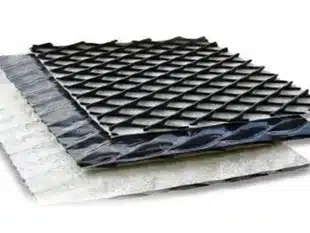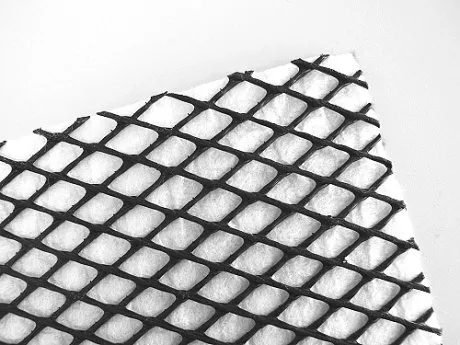+86-159 9860 6917
info@geofantex.com
geofantex@gmail.com
+86-400-8266163-44899
Geocomposite drainage layers stand as indispensable components in fortifying infrastructure against water-related challenges. These specialized layers, crafted with a blend of geotextiles, drainage cores, and filtration systems, serve a pivotal role in managing water flow efficiently. By seamlessly redirecting and filtering liquids, these layers prevent waterlogging, curb hydrostatic pressure, and safeguard structures from potential water-induced damage. Whether in road construction, landscaping, or environmental containment projects, geocomposite drainage layers offer a robust solution, enhancing the resilience and longevity of vital infrastructure.

What is a geocomposite drainage layer?
A geocomposite drainage layer is an engineered material used primarily in civil engineering and construction projects to enhance drainage and protect structures from water-related damage. This layer typically consists of a combination of two or more different materials, such as geotextiles, geonets, or geomembranes. These components are laminated or bonded together to form a multifunctional composite that facilitates efficient water flow while also providing filtration and separation.
The purpose of a geocomposite drainage layer is to efficiently collect and channel water away from structural foundations, roadways, and landscaping, thereby preventing water accumulation and reducing the risk of erosion or structural damage. These drainage systems are often used in the construction of landfills, underground structures, retaining walls, and roadways.
The benefits of using a geocomposite drainage layer include:
- Efficiency: It provides a higher flow rate compared to traditional drainage materials like sand or gravel.
- Cost-effectiveness: Reduces the need for thicker layers of traditional drainage materials, cutting down on material and labor costs.
- Installation Ease: Typically lighter and easier to install than conventional drainage systems.
- Durability: Resistant to biological and chemical environments found in soils, which extends the life of the drainage system.
These layers are particularly advantageous in areas with high water tables, poor soil drainage, or in applications where space constraints limit the use of traditional bulky drainage materials.
What is a geocomposite liner?
A geocomposite liner is an advanced engineering material used primarily in environmental containment applications. It combines different types of geosynthetics to provide enhanced performance and functionality. Here are the key aspects of a geocomposite liner:
Composition
A geocomposite liner typically consists of multiple layers of geosynthetics, including:
- Geotextiles: Non-woven or woven fabrics that provide separation, filtration, and drainage.
- Geomembranes: Impermeable synthetic membranes that prevent fluid migration.
- Geonets or Geogrids: Provide drainage and reinforcement.
- Other materials: Such as clay layers (geosynthetic clay liners) or other composites for additional barrier properties.
Purpose
The primary purposes of a geocomposite liner are:
- Containment: To prevent the leakage of contaminants into the surrounding environment.
- Barrier: To act as a barrier against liquid or gas penetration.
- Reinforcement: To provide additional structural support to the containment system.
- Drainage: To facilitate the removal of fluids or gases that may accumulate.
Applications
Geocomposite liners are used in a variety of applications, including:
- Landfills: To contain solid waste and prevent leachate from contaminating groundwater.
- Mining: To contain mining byproducts and prevent environmental contamination.
- Water reservoirs: To prevent water seepage.
- Environmental remediation: To contain contaminated soil and groundwater.
- Agricultural ponds: To prevent water loss and contamination.

What is the purpose of geocomposite?
Geocomposites serve various purposes in civil engineering and environmental applications. Their primary function is to enhance the performance, longevity, and sustainability of infrastructure projects. Geocomposites are typically made up of two or more geosynthetic materials combined to create a product with specific engineering properties. Some common purposes of geocomposites include:
- Drainage: Geocomposites are often used for efficient drainage in various applications such as retaining walls, landfills, highways, and sports fields. They facilitate the removal of excess water from the soil, preventing saturation and potential damage to structures.
- Filtration: Geocomposites act as filters to separate fine particles from water or other liquids, preventing clogging of drainage systems and ensuring the stability and performance of the underlying soil.
- Erosion Control: They help control erosion by stabilizing soil slopes, shorelines, and embankments. Geocomposites provide reinforcement and protection against surface runoff, wave action, and other erosive forces.
- Geomembrane Protection: Geocomposites can be used as protective layers over geomembranes in containment systems such as landfills, ponds, and reservoirs. They prevent punctures, abrasion, and UV degradation, thus extending the lifespan of the geomembrane.
- Gas Venting: In applications like landfills and contaminated sites, geocomposites can be employed to facilitate the venting and management of gases generated by decomposition processes, ensuring environmental safety and regulatory compliance.
- Soil Stabilization: Geocomposites contribute to the stabilization of weak or problematic soils by providing reinforcement, confinement, and load distribution. This is particularly useful in road construction, slope stabilization, and foundation engineering.
- Root Barrier: In landscaping and urban environments, geocomposites can serve as root barriers to prevent the intrusion of plant roots into sensitive areas such as underground utilities, building foundations, and pavement structures.
Overall, geocomposites offer versatile solutions for addressing various geotechnical and environmental challenges, improving the performance, durability, and sustainability of civil engineering projects.
How does geocomposite work?
Geocomposites, crafted from a blend of geotextiles, geomembranes, geogrids, or other geosynthetic materials, serve specific roles in civil engineering, environmental, and geotechnical contexts. Here’s an overview of their functionality:
- Reinforcement: Geocomposites bolster soil, retaining walls, embankments, or slopes by evenly dispersing loads and bolstering stability. For instance, a geocomposite integrated with geogrids can fortify the bearing capacity of feeble soils.
- Filtration: These composites enable the passage of liquid through the geotextiles into the geonet, diverting it away to a collection point while halting soil particle migration. This filtering mechanism aids drainage systems, preserving soil integrity and permitting water flow to minimize erosion.
- Separation: Within road construction or civil engineering ventures, geocomposites act as a barrier between distinct soil or aggregate layers, thwarting amalgamation and upholding structure integrity.
- Drainage: Tailored geocomposites are adept at draining excess water from soils or structures. They facilitate fluid movement while preventing soil particle obstruction, ensuring efficient liquid flow into the geonet and towards a designated collection area.
- Erosion Control: Utilized in erosion control, geocomposites stabilize soil and impede surface erosion. Their design allows water to traverse, averting soil particle displacement and safeguarding against erosion.
Geocomposites’ efficacy hinges on their design specifics, constituent materials, and intended applications. Their versatility in civil engineering presents solutions for challenges concerning soil stability, water regulation, and diverse construction projects.



Get Free Sample
We’ll respond as soon as possible(within 12 hours)






















